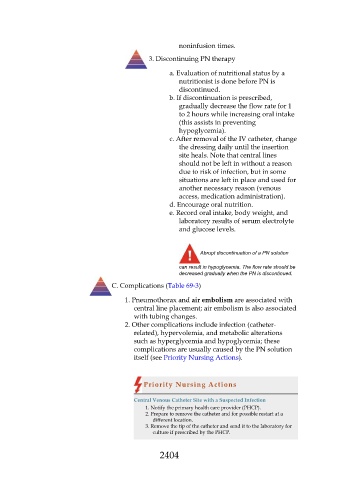Page 2404 - Saunders Comprehensive Review For NCLEX-RN
P. 2404
noninfusion times.
3. Discontinuing PN therapy
a. Evaluation of nutritional status by a
nutritionist is done before PN is
discontinued.
b. If discontinuation is prescribed,
gradually decrease the flow rate for 1
to 2 hours while increasing oral intake
(this assists in preventing
hypoglycemia).
c. After removal of the IV catheter, change
the dressing daily until the insertion
site heals. Note that central lines
should not be left in without a reason
due to risk of infection, but in some
situations are left in place and used for
another necessary reason (venous
access, medication administration).
d. Encourage oral nutrition.
e. Record oral intake, body weight, and
laboratory results of serum electrolyte
and glucose levels.
Abrupt discontinuation of a PN solution
can result in hypoglycemia. The flow rate should be
decreased gradually when the PN is discontinued.
C. Complications (Table 69-3)
1. Pneumothorax and air embolism are associated with
central line placement; air embolism is also associated
with tubing changes.
2. Other complications include infection (catheter-
related), hypervolemia, and metabolic alterations
such as hyperglycemia and hypoglycemia; these
complications are usually caused by the PN solution
itself (see Priority Nursing Actions).
Priority Nursing Actions
Central Venous Catheter Site with a Suspected Infection
1. Notify the primary health care provider (PHCP).
2. Prepare to remove the catheter and for possible restart at a
different location.
3. Remove the tip of the catheter and send it to the laboratory for
culture if prescribed by the PHCP.
2404

